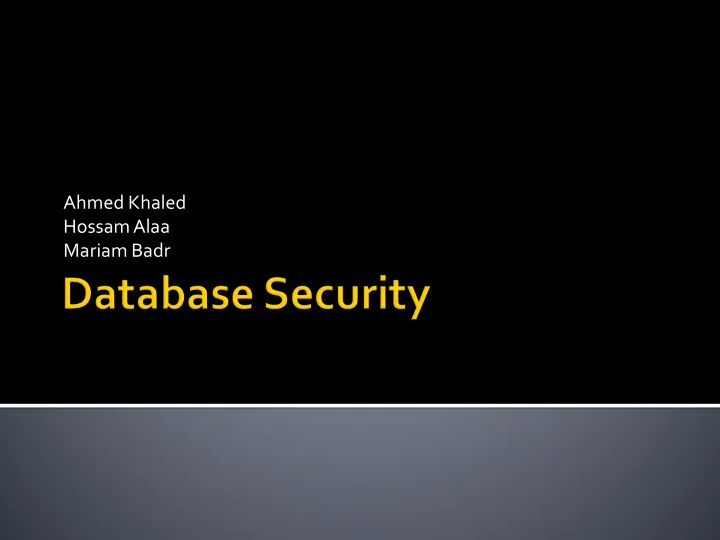

Ahmed Khaled Hossam Alaa Mariam Badr
Bank Accounts Credit Cards Information Applications users Licenses and certificates
Identity thefts Systems hacking Illegal transactions Most web and network applications are vulnerable
Database itself Application Programs Database Management Server (DBMS) Network connected to Database Web Server connected to Database
Physical level Traditional lock-and-key security Protection from floods, fire, etc. ▪ E.g. WTC (9/11), fires in IITM, WWW conf website, etc. Protection from administrator error ▪ E.g. delete critical files Solution ▪ Remote backup for disaster recovery ▪ Plus archival backup (e.g. DVDs/tapes) Operating system level Protection from virus/worm attacks critical
To encrypt the database at storage level, transparent to application ▪ Whole database/file/relation ▪ Unit of encryption: page ▪ Column encryption Main issue: key management ▪ E.g. user provides decryption key (password) when database is started up Supported by many database systems ▪ Standard practice now to encrypt credit card information, and other sensitive information
Encrypting at Application Layer Must do it at multiple locations from within app. Data can only be used from within application Encrypting at File System/Operating System Layer less flexible. Requires you to encrypt everything. Performance degrades Weak for handling Disk Theft problem. Encrypting within Database Usually, most practical option
Application Developers use a cryptographic library to encrypt such as Java Cryptographic Extensions (JCE) – set of APIs in the java.security and java.crypto packages
SQL Server 2005 you can access Windows CryptoAPI through DB_ENCRYPT and DB_DECRYPT within T-SQL (similar to PL/SQL) Can use DES, Triple DES and AES (symmetric keys) In ORACLE, you can access DBMS_OBFUSCATION_TOOLKIT package that implements DES and Triple DES
DB Encryption can be divided into Data-in- transit and Data-at-rest Encryption is useful as a last layer of defense (defense in depth). Should never be used as an alternative solution Encryption should be used only when needed Key Management is Key
Network level: must use encryption to prevent Eavesdropping: unauthorized reading of messages Masquerading: ▪ pretending to be an authorized user or legitimate site, or ▪ sending messages supposedly from authorized users
All information must be encrypted to prevent eavesdropping Public/private key encryption widely used Must prevent person-in-the-middle attacks E.g. someone impersonates seller or bank/credit card company and fools buyer into revealing information ▪ Encrypting messages alone doesn’t solve this problem
One mechanism to allow specific users access only to required data Password Smartcards
Central authentication systems Allow users to be authenticated centrally MS Active Directory often used for central authentication and user management in organizations Single sign-on: authenticate once, and access multiple applications without fresh authentication
Different authorizations for different users Ensure that only authenticated users can access the system And can access (read/update) only data/interfaces that they are authorized to access
Application authenticates/authorizes users Application itself authenticates itself to database Database password Application Database Program
Applications are the biggest source of insecurity Poor coding of application may allow unauthorized access The applications may be very big.
E.g. application takes accnt_number as input from user and creates an SQL query as follows: string query = "select balance from account where account_number =‘" + accnt_number +"‘ “
select balance from account where account_number =‘ 123 ’
What if I entered 022572636 ‘ or 1=1 Now its select balance from account where account_number =‘ 022572636 ‘ or 1=1
http://www.example.com/index.php?id=123 Just add ‘ http://www.example.com/index.php?id=123 ’
To prevent SQL injection attacks use prepared statements (instead of creating query strings from input parameters) • use stored procedures • use a function that removes special characters (such as quotes) from strings
Most security schemes address outsider attack Have password to DB? Okay, you can update anything Bypassing all security levels ▪ The more people have access, the more danger The application program has the DB password Great deal of trust in people who manage databases
Chapter 8 of Database System Concepts 5 th Edition, Silberschatz, Korth and Sudarshan, McGraw-Hill The Open Web Application Security Project http://www.owasp.org Web application security scanners e.g. WebInspect (SPI Dynamics) http://www.windowsecurity.com/software/Web-Application-Security/ SQL Injection http://www.cgisecurity.com/development/sql.shtml 9 ways to hack a web app http://developers.sun.com/learning/javaoneonline/2005/webtier/TS-5935.pdf Related research papers Kabra, Ramamurthy and Sudarshan, Redundancy and Information Leakage in Fine-Grained Access Control, SIGMOD 2006 Rizvi, Mendelzon, Sudarshan and Roy, Extending Query Rewriting Techniques for Fine-Grained Access Control, SIGMOD 2004
Recommend
More recommend